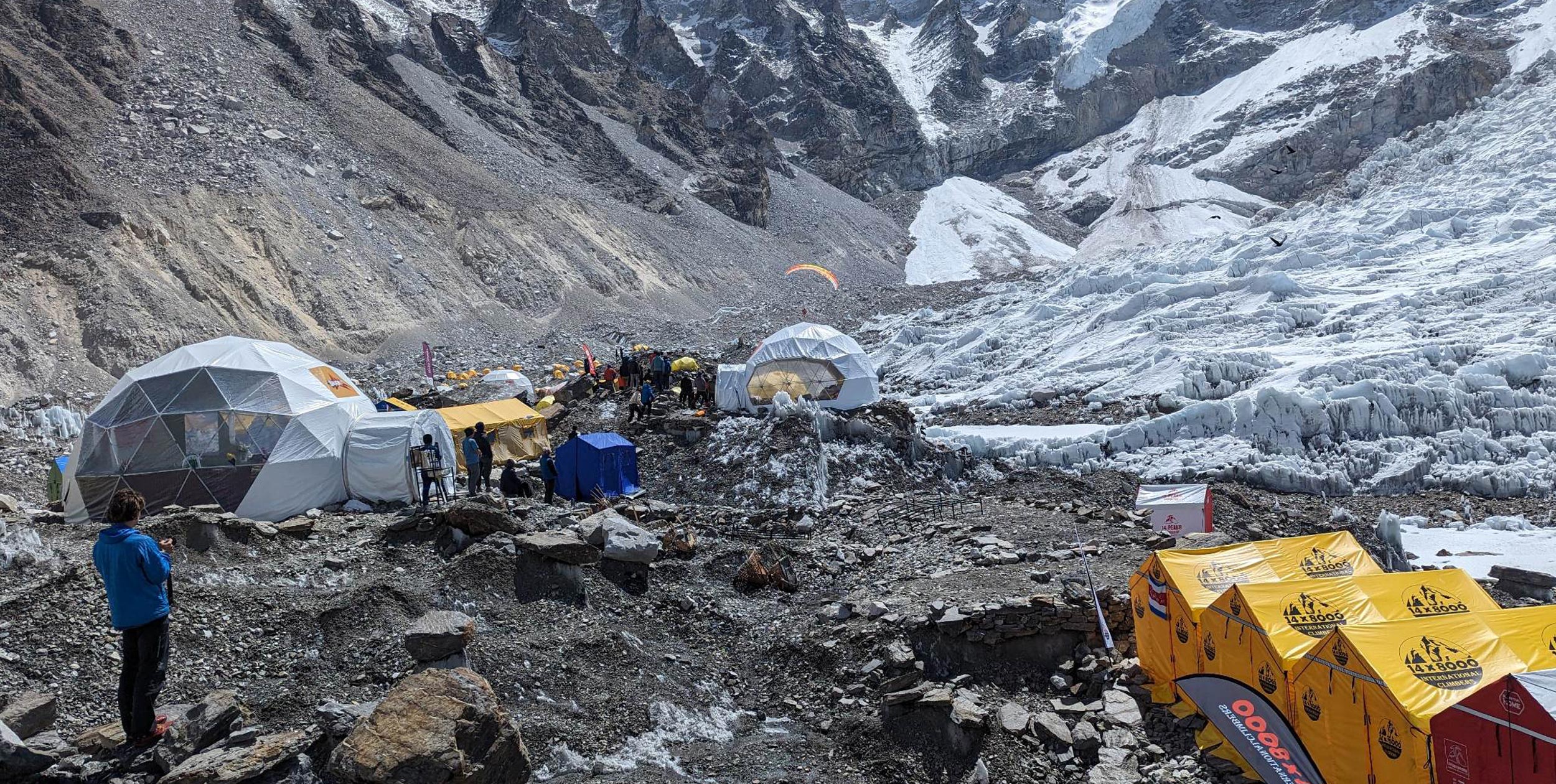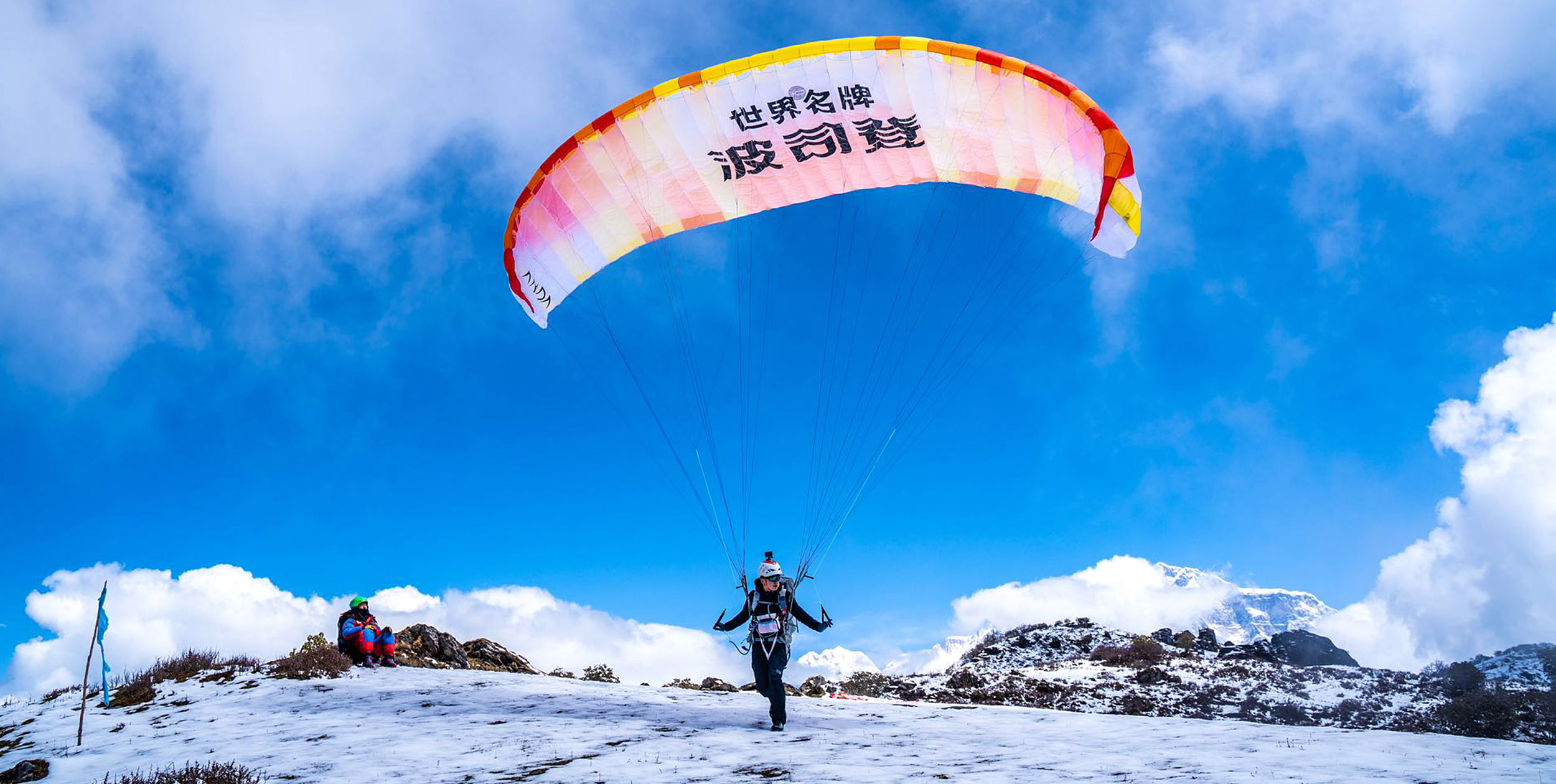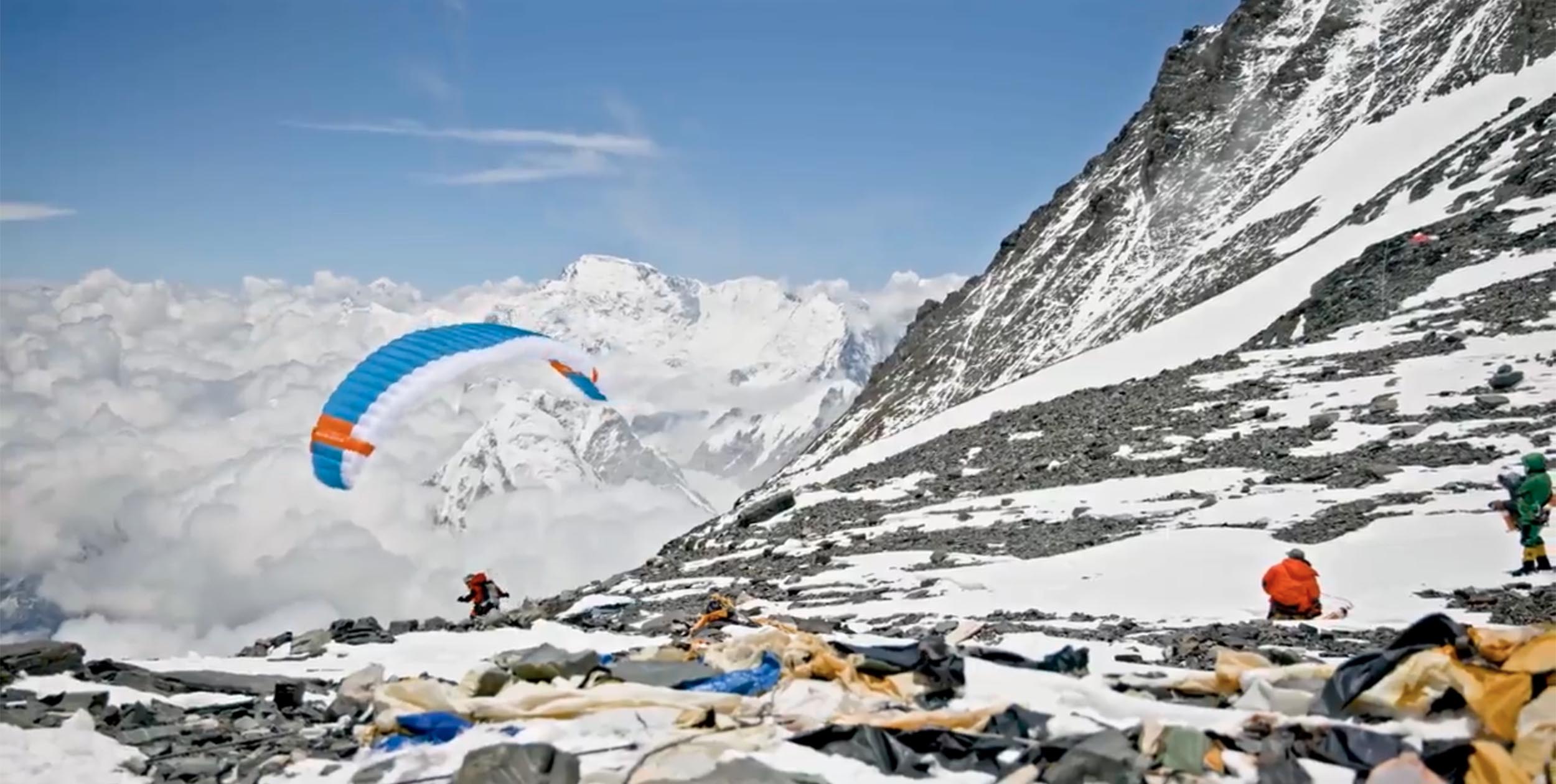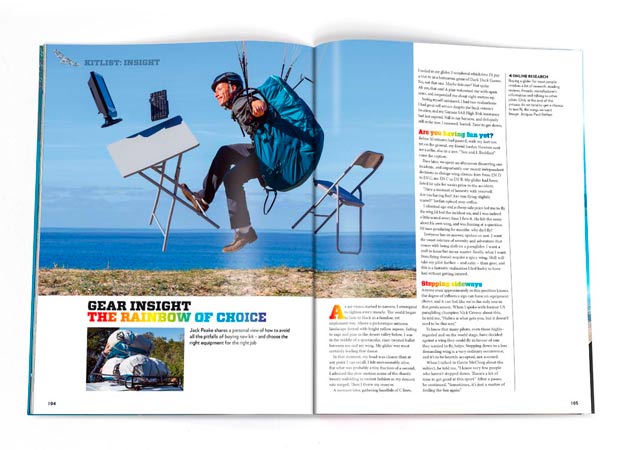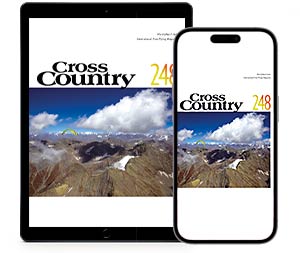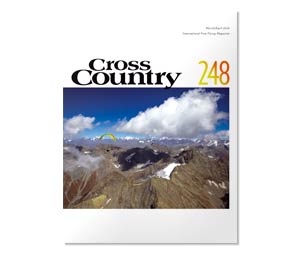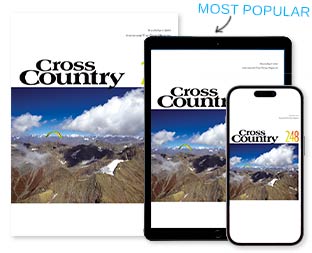A view from the summit of Everest, shot in 2005 by Tim Mosedale, a UK climber. Claire and Zeb flew off the north side into Tibet
An interview with Zebulon Roche and Claire Bernier, the intrepid adventurers who this year completed their dream of flying from the highest summits of the world’s seven continents. By Hamish Barker. Published in Cross Country magazine in 2001
In the northern spring of 2001, I was paying close attention to a number of websites on the theme of “Mount Everest”.
Scotty, my old climbing friend, and Theo, who led my first long ski tour, were up there, fighting cold, snow, thin air and (sad to say it happens even in these wild places) oxygen cylinder-thievery to try to reach the highest point on Earth.
Theirs is another story, but the connection to this one was one of the reports on those websites, saying “someone flew off the summit today!”. That someone not only climbed “the big E”, but had also the energy to drag along a paraglider was astounding. I knew who it had to be, but not much more about them. Claire Bernier and Bertrand (but everyone calls him “Zebulon”) Roche were nearing completion of an odyssey, to climb and fly from highest summits on every continent of the earth*.
Zebulon and Claire are both 28 years old. Both have been members of the French national paragliding team, and Claire was Paragliding World Cup women’s champion in 1995, 1997 and 1998. Zebulon has been climbing and flying since he was a child, and climbed Everest when he was 17 years old.
Back to the grassy hillside, where I sat next Zebulon, Claire and their dog with my dodgy walkman and questions at the ready…
Hamish: So we’ll start with why did you start paragliding?
Zebulon: Well, I start paragliding after, actually, after seeing my daddy coming back from an expedition with this strange thing in his backpack. And so, after playing with this strange, ah, engine, I really fell, not fell in love with paragliding, but, I was just like a virus had me, and so…
(Zeb is cut off by the blaring engine of an aerobatics plane buzzing the paragliding launch.)
H: So you started paragliding in which year?
Z: Nineteen eighty-four.
Claire: I started in eighty-eight because my father started first and then he offered me a training course because he was sure that it would please me.
H: In the past, you have both flown a lot of competitions. What were the highlights of that?
C: The best parts for me were to go every weekend to a new place and to fly with a lot of different people, and after it was always the same people it became to be like a family, and we were always happy to pack our stuff for the weekend and to go for those competitions.
It was really like more fun than competition actually. And with the years going on, it started to be like more professional, with money and stuff, so then it started to be more serious. And it was funny as well, but a bit less.
But we could live on that, so it was good as well. But at the end I wanted to change because it’s too much risk and too much time for this. Too much waiting as well, and you waste your time. Life is short, so we wanted to do something that we could do as well on the bad weather.
Like mountaineering. You can go if it’s too windy, and then choose your day for flying. So that we do it [flying and mountaineering] with the seven summits.
Z: Yeah, for me the same. The pleasure of flying is really really something in my blood now. I mean, I feel bad if I don’t fly for (laughs) several months –
H: Not days?
Z: Several days, yeah, months, it never happens eh? But so, I really love to fly, so competition for me was really really funny because I like to compete also, and I like to try to be the best. And so, it was a very good experience for me.
Ah, when I was in the French team, so it was during from 1995 to 1999, that was, I think, the best time for my flying part I remember, where I had a lot of fun. And now I’m still having fun a lot with this new project, which is completely different from competition.
But like Claire said, it’s sometimes when you are in competition, and you can fly and make hundreds of kilometers, that’s something very fantastic. But when you wait for weeks and weeks to fly and the weather is not there, sometimes you’re just “ah, what am I doing here, I don’t want to do this all my years.” That’s why we needed to change something.
H: Okay, onto your “Seven Summits” project. When I met you this morning I was just speechless to meet “these two people” with such determination, courage, and so far a lot of achievement. My biggest congratulations to both of you.
C: Thank you.
H: And I’m sure everybody in the Australian paragliding community is proud to have two people like you in the international paragliding family. Okay, what gave you the idea to do the “Seven Summits” with a TANDEM paraglider?
Z: Actually, the tandem is two points. One point is the security, because if one of the two cannot fly, in tandem, nobody flies. Or both of us fly. So that’s the first security, not to have to go down alone, or find the other somewhere we don’t know. And the other part is the weight. The weight of two gliders is always heavier than one glider. So that’s why we chose this one. And also we really like to fly together. It’s not a problem for us.
H: And in terms of actually thinking, “right, we’re going to fly off the seven highest summits in the world”?
C: The project came out because we went for three months in South America, where we were flying off the highest summit of each country we visited. So it started like this. It was just for us alone, and we did it in Bolivia, Chile, Peru, and Ecuador.
And after that it really pleased us, so we tried to, but it’s expensive, so when we came back home we had no more money, and we were thinking of how to continue this, this life, this lifestyle, because we like that, without spending our own money by interesting some other people.
So we thought we should find a project which could interest some medias, so Zeb told me that there were a classic, which is called the seven summits. Me, I didn’t know about it. And then we read a lot about it, and started to get into the project, and we made a brochure and we found sponsors. We started by the small budget one –
Z: The one we could pay ourself!
C: And then went for the big one with the good sponsors that we had on the PWC. Like Red Bull, SupAir, Ozone and stuff like that.
H: What did you expect, ah, I think one of the most difficult, logistics-wise must be the Vinson Massif in Antarctica. To get there must be quite hard?
Z: Yeah, actually for the Vinson Massif there’s an organisation which is called A.N.N.I. and they are organising this kind of trip. The problem for us is to find the money, because it’s really expensive. And you can imagine, it’s not easy to get to Antarctica, it’s a really big, big country, like one and a half [times as big as] the United States, so it’s really big.
And the planes are flying there only by good weather, because they don’t have all the material for landing with IFR. So it’s like REALLY really, really important to have good weather condition. But yeah, every peak is different, every peak is a big organisation, and actually, when we are on the plane to the peak, a part of the expedition is already done.
H: What did you expect in Antarctica?
C: Well, in Antarctica we were really wondering if it would be flyable, so we were expecting not much really. We were kind of, wondering. But we were really looking forward to seeing this, because it’s so uncommon to go there, and we have been very lucky to find the budget to be able to go there, and it was a fantastic place. We were really happy.
H: What did you expect to encounter on the Everest trip, and how did it compare with the reality?
Z: Well, I didn’t want to prepare too much in my head. My philosophy is to live the mountain as it is in reality. I don’t want to have any idea before, otherwise you come there, and you think you are doing this or this, and you think you’re going to be cold or you think you’re gonna be scared or, I don’t know, and that’s not like the mountain I like.
So I prefer to go there without any, idea, and I don’t like to read any book, like for example “Into Thin Air”, or those kind of books. You know, they can put you in a bad mind for this trip. But I didn’t expect it to be easy, and I didn’t expect it to be really flyable actually. So I was quite suprised that we could make it.
H: Will you go back to the Himalaya?
Z: Actually, I’m not sure I’m going back to the Himalaya for climbing 8000 meters peaks or something hard like that. I’m at Val Cenis [in the French Alps] because it’s a really pleasant place. I love the people there, I love the philosophy of the people. They are really, really kind, and you can go everywhere without thinking of your safety.
It’s maybe changing but as I know, some places are really really nice and, but I’m not really interested in doing extreme stuff and things like that. I really prefer, sharing what I’m living, with somebody, with my wife or some other people. Showing them a very nice place, nice place, nice lifestyle.
H: Claire, will you go back to the Himalaya?
C: Yes of course, to the Himalaya for trekking or a trekking summit, but not for an eight thousand [meter peak].
H: Claire, what is the best flight that you’ve done?
C: I think the best flight, I have so many best flights, it’s difficult, ah! 🙂 But, well each summit, I think was a really, beautiful, wonderful flight. But the most beautiful flight was the flight, I think, from the McKinley [Mount McKinley, highest peak in North America] because it was a long flight, and we didn’t know where we would land. And we took off, it was a really nice takeoff, at seven P.M. We landed forty-five minutes later under a light rain, with lots of mosquitos, in the tundra.
Z: And the bears which were looking at us, waiting for, for some fresh meat.
H: Num num…
(laughs all round)
H: What do you like the most about paragliding?
Z: I think when my feet quit the ground, that’s always a big pleasure.
C: Yeah me too, it’s always a fantastic sensation when you get the lift from the glider and you leave the ground and you feel like a bird for a while and that’s a great sensation. And then to see everything from the sky, it’s kind of attractive as well, oui, always.
H: What do you like the least about paragliding?
Z: When we have to go down with the backpack and cannot fly actually.
C: Well, because I think it’s a slow machine, so there’s lots of inconvenience.You can not start in high wind, you have to take care of turbulences because you are very [limited], oui.
H: You have travelled to a lot of wild places, and I guess you have seen a lot of the local people in some really different places. What are your impressions of people in, well, wherever?
Z: Well I think it’s really important to see the people and to live a little bit with them. And
I really appreciate each time we are going somewhere to go and try to speak to the locals and see the way of their life, and that’s, I think, really important in our travel, to be a bit interested in the local life, you see.
C: Well, as well I think that the way we are travelling, that means we are always walking and have big rucksack because we always have our glider with us. It’s very easy to meet people, because paragliding is a small community so you will meet easily some other pilots, or you will meet easily some farmers who will explain you stuff, it’s very nice.
H: What do you think about flying in the big mountains or flying in the flatlands? What’s special?
Z: As long as it’s flying, I love everything. So flying in flatlands, sometimes it’s great. Flying in mountains, it’s always wonderful because the mountains are always different. Flatlands, it’s not always the same, but, it’s, I mean, it’s compl- yeah it’s flat. That’s the main thing. Flying in different mountains, different continents, it’s always different mountains, different climate and that’s what makes it really exciting. I really love mountains for that.
C: Well, it’s very interesting. I love differences so each time you have to work on your technique and to be slower in the flatlands, to take care of the houses, the birds and everything, and in the mountains you just go fast.
H: Future plans?
C: Future plans, it’s we want to do the last summit for next year, and now we are waiting for a kid for March.
Z: Yeah, so the baby first, and then after, some new project. We are also flying ultralight. She is already waiting for a baby, four months!
H: What do think will happen in paragliding’s future?
Z: Paragliding’s future? I think it’s going to be still really nice, and I hope we will have more light gliders, especially for flying, easily. I mean, walking and flying, that’s the main thing that we want to push on, is to develop all this FREE flying, which is walking, really free. You go on the mountain and you fly, and that’s really, for me, THE paragliding.
C: I don’t think that it’s going to explode like many other sports. It’s gonna be always small and comfortable that’s all. Small market and, voila, we have to deal with that.
H: Do either of you have any advice for people that are starting flying?
C: Go Slowly
Z: Yeah, take your time, and like I said before, a good pilot is an old pilot, so have fun.
Footnote
The Seven Summits are:
*Mt McKinley, 6190m, Alaska, North America
Mt Elbrus, 5642m, Caucasus mountains, far south-east Europe
Mt Kilimajaro, 5885m, Tanzania, Africa
Aconcagua, 6860m, Argentina, South America
Vinson Massif, 5140m, Antarctica
Mt Everest, 8848m, Nepal/Chinese occupied Tibet, Asia
Still uncompleted: Carstensz Pyramide (aka Pk Jaya), Irian Jaya, Oceana (it seems that Australia has lost its continental status according to the French! Otherwise Kosciousco would be easy-peasy for the seventh summit.)
Thanks to Hamish Barker and Australia Paragliding News
• Got news? Send it to us at news@xccontent.local
Subscribe to the world’s favourite hang gliding and paragliding magazine

